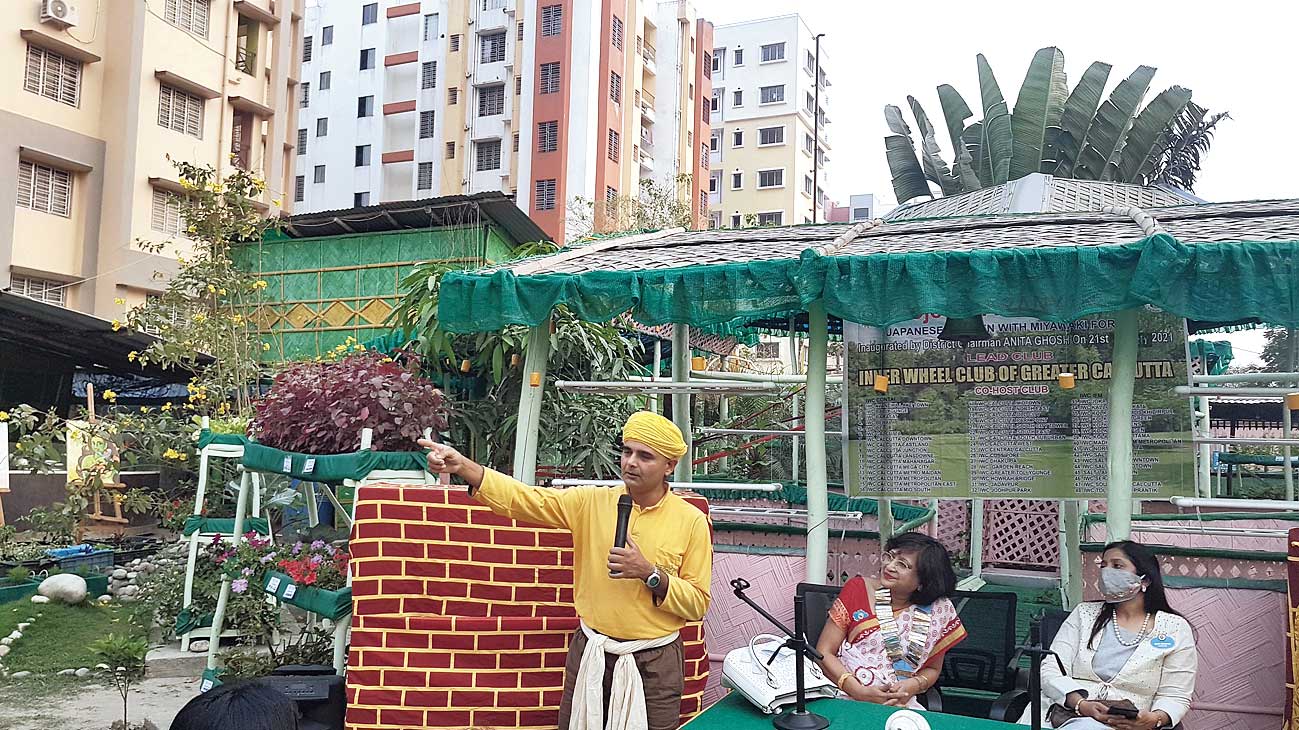It takes some 300 hundred years for nature to create a forest but using a Japanese technique, a plot opposite the convention centre in New Town is being developed such that a man-made forest becomes ready in only 20 to 30 years.
The plot lies within Karmyog Green Village, that itself is a green strip created out of a garbage dump along Bagjola canal side. The Karmyog team has set up the “Miyawaki forest” with support primarily from the Inner Wheel Club of Greater Calcutta and also by 50 other Inner Wheel clubs under district 329.
Japanese garden
Akira Miyawaki is a 93-year-old Japanese urban botanist who has developed the method in question. “The Japanese love greenery but have limited space so he came up with the idea of building mini forests in decades instead of centuries,” said Sourabh J. Sarkar, co-founder of Karmyog Green Village, who has spearheaded the project.
Miyawaki asks planters to use native species and for them to be planted as per height. So the inner-most layer has tall canopy trees like Jackfruit and Mango. Next comes the understorey layer with medium-sized trees like Pomegranate and Guava. Short shrubs like Syngonium and Rapish Palm will come up to knee-level level and ground cover species like Rhoeo grow horizontally and cover the soil.
“We also have a waterbody that has plants growing and we haven’t removed the algae on it as we want to keep it natural,” says Sourabh. Through the jungle is a pathway to take visitors around a sanctum sanctorum of sorts before leading right to it.
“The concept of encircling the shrine is used in various places of worship. We shall have mnemonics of all religions — to show harmony — and right at the centre will be a massive banana tree. So in a way we are viewing nature as God,” says Sourabh. While this is not strictly out of Miyawaki’s book, the spirit, he says, is the same.
They have come up with triple-decker bamboo panels too, with soil on every shelf growing cabbage, cauliflower, tomatoes etc. These panels overcome the problem of space and use nutritious soil that Karmyog is preparing with manure, cowdung etc. “Our attempt is to use minimum soil for maximum nutrition.”

Visitors welcome post-Covid
The forest has bamboo structures meant to support creepers and hold up placards with information about the plants. There will also be audio-visual descriptions. It is shut now because of the partial lockdown but will allow visitors to come and even let them feed fish in the water body.
“Our objective is to have people come, learn and replicate the system at home. A 4ft x 10 ft bed in one’s balcony is enough for the humblest form of this forest,” says Sourabh, adding that they shall hold workshops for anyone interested to spread the knowhow. “The tallest trees on the ground do not exceed a height of two or three floors so how can people living in the 20th floor connect with nature? For them these micro-forests are most suitable.”
The forest, when it reopens, will be open to visitors between sunrise and sunset, which is the clock Karmyog works by. “Wouldn’t it be nice for parents to have a place like this to take children to instead of the mall? They can absorb the ambience of the woods without having to drive out of city,” says Sourabh’s wife Reena, who is also involved with the project.
The forest materialised after the Inner Wheel Club approached Karmyog. “We’re lucky to have found this group. Where else in New Town could we have found space for a jungle?” asked Saswati Pal, president of Inner Wheel Club of Greater Calcutta, at the inauguration.
Inner Wheel’s district chairman Anita Ghosh pointed out how important greenery was for oxygen and pollution alleviation. “In an age when agricultural land is being converted into concrete jungles we, on the International Day of Forests, are glad to have initiated an urban forest,” she said.











